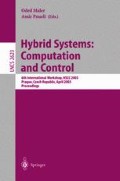Abstract
In this paper we propose an algorithm for solving a Multi-Object Adaptive Cruise Control problem. In a multi-object traffic scene the optimal acceleration is to be found respecting traffic rules, safety distances and driver intentions. The objective function is modelled as a quadratic cost function for the discrete time piecewise affine system. We find the optimal state-feedback control law by solving the underlying constrained finite time optimal control problem via dynamic programming.
Radar sensors at the same time provide distance and relative speed measurement.
Access this chapter
Tax calculation will be finalised at checkout
Purchases are for personal use only
Preview
Unable to display preview. Download preview PDF.
References
Richtlinien für die Anlage von Strassen (RAS-L-1), Forschungsgesellschaft für Strassen-und Verkehrswesen, Köln, (1984)
Zapp, A., Dickmanns, E.D.: A curvature-based scheme for improved road vehicle guidance by computer vision. SPIE conference on mobile robots, (1986)
Franke, U., Gavrila, D., Gern, A., Goerzig, S., Janssen, R., Paetzold, F., Woehler C.: From Door to Door-Principles and Applications of Computer Vision for Driver Assistance Systems. Intelligent Vehicles Technologies: Theory and Applications, Arnold, (2000)
Franke, U., Gavrila, D., Goerzig, S., Lindner, F., Paetzold, F., Woehler, C.: Autonomous Driving Goes Downtown. IEEE Intelligent Systems, Vol. 13(6):40–48, (1998)
Liubakka, M.K., Rhode, D.S., Winkelman, J.R., Kokotovic, P.V.: Adaptive Automotive Speed Control. IEEE Transactions on Automatic Control, Vol. 38(7):1011–1020, (1993)
Ha, I., Tugcu, A.K., Boustany, N.M.: Feedback Linearizing Control of Vehicle Longitudinal Acceleration. IEEE Transactions on Automatic Control, Vol. 34(7):689–698, (1989)
Won, M. Hedrick, J.K.: Disturbance Adaptive Discrete-Time Sliding Control With Application to Engine Speed Control. Journal of Dynamic Systems, Measurement and Control, Vol. 123(1):1–9, (2001)
Bar-Shalom, Y., Fortmann, T.E.: Tracking and Data Association. Academic Press INC, San Diego, New York (1988)
Bar-Shalom, Y., Dale Blair, W.: Multitarget-Multisensor Tracking: Applications and Advances Volume III. Artech House, Boston, London, (2000)
Blackman, S.S.: Multiple Target Tracking with Radar Applications. Artech House, (1986)
Magill, D.T.: Optimal Adaptive Estimation of Sampled Stochastic Processes. IEEE Transactions on Automatic Control, Vol. 10(4):434–439, (1965)
Blom, A.P., Bar-Shalom, Y.: The Interacting Multiple Model Algorithm for Systems with Markovian Switching Coefficients. IEEE Transactions on Automatic Control, Vol. 33(8):780–783, (1988)
Sontag, E.D.: Nonlinear regulation: The piecewise linear approach. IEEE Trans. Automatic Control, 26(2):346–358, (1981)
Borrelli, F., Baotic, M., Bemporad, A., Morari, M.: An efficient algorithm for computing the state feedback optimal control law for discrete time hybrid systems. Technical Report AUT02-04, ETH Zurich, http://control.ethz.ch/~hybrid/hysdel, (2002)
Bemporad, A., Morari, M., Dua, V., Pistikopoulos, E.N.: The explicit linear quadratic regulator for constrained systems. Automatica, 38(1):3–20, (2002)
Borrelli, F.: Discrete Time Constrained Optimal Control. Dr.sc.tech. thesis, Swiss Federal Institute of Technology (ETH), Zürich, Switzerland, (2002)
Author information
Authors and Affiliations
Editor information
Editors and Affiliations
Rights and permissions
Copyright information
© 2003 Springer-Verlag Berlin Heidelberg
About this paper
Cite this paper
Möbus, R., Baotic, M., Morari, M. (2003). Multi-object Adaptive Cruise Control. In: Maler, O., Pnueli, A. (eds) Hybrid Systems: Computation and Control. HSCC 2003. Lecture Notes in Computer Science, vol 2623. Springer, Berlin, Heidelberg. https://doi.org/10.1007/3-540-36580-X_27
Download citation
DOI: https://doi.org/10.1007/3-540-36580-X_27
Published:
Publisher Name: Springer, Berlin, Heidelberg
Print ISBN: 978-3-540-00913-9
Online ISBN: 978-3-540-36580-8
eBook Packages: Springer Book Archive

